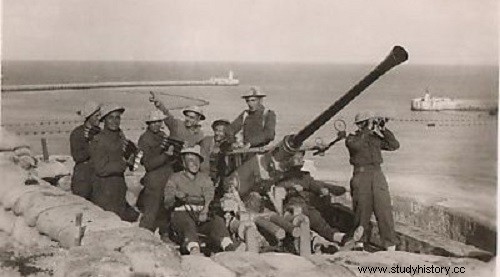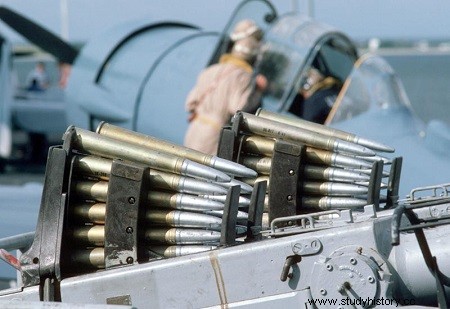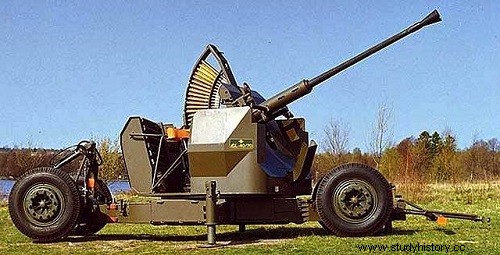
The 40 mm Bofors is an anti-aircraft gun designed by the Swedish gunsmith Bofors in the early 1930s. Its initial version was called 40L60, because the barrel has a theoretical length equal to 60 times the caliber. It was manufactured in Sweden by the Bofors company itself, but also under license in many other countries. Many of the nations involved in the Second World War used it in different versions, and even after. Many versions are still in service in the 2010s.
History
Bofors MK 12 quadruple hide on the aircraft carrier Hornet (during an exercise circa February 1945).
A Swedish Army Combat Vehicle 90 model CV9040 armed with a 40mm gun mm with a magazine of 120 shells.
The 40mm Bofors was used on almost all major British and American ships from 1943 to 1945. Fitted with the new Mark 51 sighting system, it became a dreaded weapon, credited with half of the Japanese aircraft shot down between 1 October 1944 and February 1, 1945.
The 40 AA 39/55 version was still in service in the "ground-to-air" artillery regiments of the French army in the 1970s (in particular in the 7th Marine Anti-Aircraft Artillery Group in Colmar, then 57th artillery regiment)
In the French Navy, at the beginning of 2015 there were still five ships each equipped with one of these weapons:the four of the P400 class and the Albatros decommissioned in July 2015.
It equips several types of vehicles at the beginning of the 21st century, including a version of the Combat Vehicle 90.
Features
For the 40L60 version
Useful range in anti-aircraft :3,800 m by self-destruction of the shell,
in anti-personnel :3,000 m,
in anti-tank :1000 m;
maximum range greater than 7,000 m.
Weight of the anti-aircraft shell 0.890 kg for 68 g of explosive. The complete shot (casing, shell and propellant charge) weighs 2.12 kg.
Generally, 4 shots are combined in a magazine blade, to be easily introduced by hand into the hopper located on the upper face of the part. The hopper can receive 2 blades, or 8 shots, which will be fired in 4 seconds; on the revolving platform of the piece, a shelf can contain 7 additional blades (28 shots), which the serving outfitter can bring successively into the hopper during the firing. A ground server can introduce new blades into the platform shelf from the outside if necessary.
Initial speed
850 m/s at the exit of the tube
Rate of fire 120 strokes per minute5

At least for the model still in service in the army French in the 1970s, each coin had two tubes, one in place on the coin, and the other in reserve in a crate. The tube is assembled on the part by an interrupted thread, to be able to dismantle it by rotation of a sixth of a turn:this allowed, after dismantling, to let the tube used cool, while keeping the part in service with the second tube reassembled in place. The tube changing operation required at least three servants, and could be done in about 30 seconds by a well-trained team; in fire school, the change of tube was done every 80 rounds.
In addition to the anti-aircraft shell, there was another explosive shell for anti-tank use, and a non-explosive practice shell (nicknamed "cannonball").

For the 40L70 version
A lengthened version baptized 40L70 (tube of length 70 gauges) with higher initial speed (1.000 m/s) and higher rate of fire (240 even 330 rounds per minute) was studied after the war. But for France, this model was finally abandoned at the end of the 1950s, in particular because of its mass (5 tons instead of 3) and its cost.
Country Sweden
Type Autocannon
Ammunition 40 mm shell
Manufacturer Bofors
Commissioning 1930
Service life 1932 - still in use
Weights and dimensions
Mass (unloaded) L/60:1,981 kg
L/70:5,150 kg
Barrel length 56 - 70 calibres
Technical features
Maximum range L/60:7,160 m
L/70:12,500 m
Rate of fire L/60:120 shells/min
L/70:330 shells/min
Muzzle velocity L/60:881 m/s
L/70:1021 m/s
